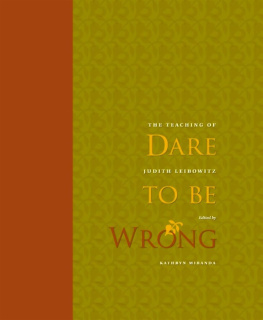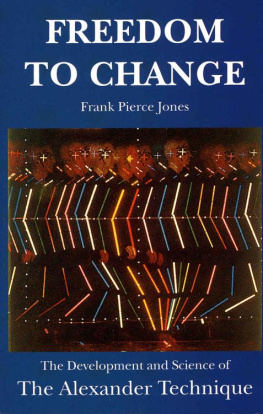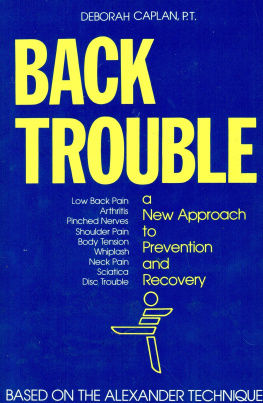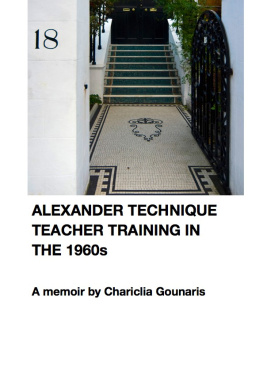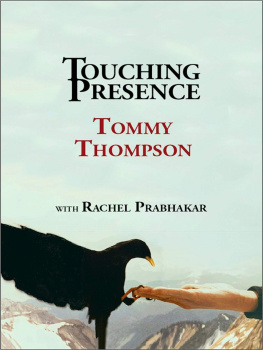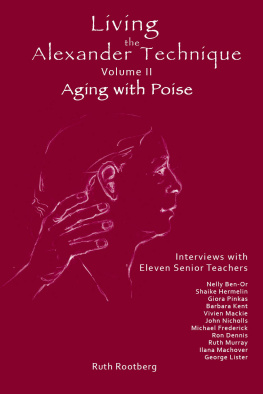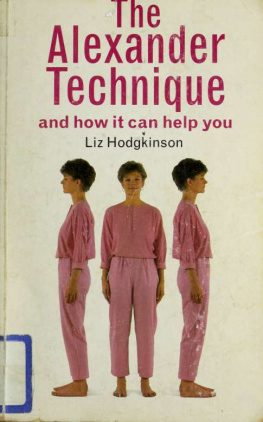Dare to let it feel wrong. Take a chance on letting me give you an experience that you dont think is right. When you walk out of this room you can always go back to what feels right. But right now, youre allowing both of us the luxury to make a mistake.
Edited by Kathryn Miranda
Foreword by Barbara Kent
For Judys students, trainees, colleagues and friends so that you may remember Judys teaching. For all Alexander teachers and students in Teacher Training Programs so that you may learn about the inspirational teaching style of Judith Leibowitz.
The way you teach grows out of who you happen to be. The only thing that I can do is bring up things that I have found useful in teaching and show you how I get people to do these things.
Judith Leibowitz
2006 American Center for the Alexander Technique, New York, N.Y.
All rights reserved
Forward
By Barbara Kent
December, 2006, New York City
I had the good fortune to meet Judy Leibowitz in 1962 through my voice teacher, Gladys Lea. My good friend Ilana Rubenfeld had sent me to Gladys knowing (I discovered later) that Gladys would send me for Alexander Technique lessons, as she did with all her voice students. She had studied with Judy and was devoted to the Alexander Technique. Gladys sent me for lessons with Frank Ottiwell, and from time to time I would have a lesson with Judy. Judy was always present at Gladys Musicales and often gave me some hands-on work before I sang, or would simply be a shining example of up and out from the audience. What a deeply influential role this woman would play in my life.
After Frank moved to California Judy became my primary teacher. Both Frank and Judy had been nudging me to train to teach. Finally Judy won me over and I entered the teacher training program in 1969. Thus I immersed myself into the Alexander world of Judy Leibowitz and The American Center for the Alexander Technique (ACAT), which would shape and influence me for all time to come.
Several years after Judys death, I began to realize that some people entering ACATs Teacher Certification Program had never known or even heard of Judy. Surely the current training faculty spoke of Judy often, but when someone said, Judy who? I knew something had shifted. Somehow I had just assumed that Judys style of teaching and her countless contributions to ACAT and the Alexander Technique would continue to be obvious. Although I knew that Judys influence lived on in our teaching, I was coming to understand that ACAT needed a more proactive tack to pass on her legacy.
Judy, through her development of ACAT and her love and support of it, deeply influenced many of the people whom she trained to teach the Alexander Technique. When Kathy Miranda presented a proposal to the ACAT Board to transcribe and edit tapes of Judys lessons, classes, workshops, and interviews I felt sure this was an important step in preserving that legacy.
I was delighted when Kathy invited me to participate in the project. The chance to revisit Judys teachings through reading the transcribed material seemed like a treat. It was! It was like having lessons with Judy again. A flood of images and memories, verbal, kinesthetic and emotional washed through me. The most vivid impressions that linger involve Judys unwavering personal commitment to and trust in our wholeness and our ability to grow and change. From that secure belief in wholeness she could lead you on a voyage of discovery as she called it charted by steadfast reliance on the process of inhibition and direction. Her lessons encompassed as much physical detail as was needed, and as much attention to attitudes and beliefs as one was ready to meet. What a rich mosaic of learning!
Kathys project has given ACAT a lasting record of Judys teaching and a testament to the depth of her influence. The highlight of which is Dare To Be Wrong . With its publication, Judys legacy will be acknowledged and renewed, presenting readers with her ideas, understandings, experiments and experiences in her own words.
I invite you to look forward with a curious mind to meet or revisit Judy Leibowitz.
PREFACE
As a graduate of the American Center for the Alexander Technique (ACAT), I am indebted to Judy Leibowitz. If not for her creative vision and her strong drive to make this organization effective, ACAT would not have survived and I would not have received such excellent training. Along with Deborah Caplan, Frank Ottiwell, Barbara Callen and Joyce Ringdahl Suskind, Judy founded ACAT in 1964 as a center, a place for teachers to come together to support each other, a place to train teachers and a place for the public to learn about Alexander. It was the dynamic, collegial style of ACAT that drew many to train there. I went in the fall of 1987 and over the course of three years, I studied with twelve trainers and another dozen or so assistant trainers, but Judy was the main influence in my training. I had approximately 200 hours in her training classes and all my other trainers had been influenced by her, either through training or by exchanging work with her. (All but Deborah Caplan and Sarnell Ogus were graduates of ACATs Teacher Training Program.)
When Judy died in December of 1990, little had been written about her. Her book The Alexander Technique, The world-famous method for enhancing posture, stamina, well-being, and for relieving pain and tension, which she co-wrote with Bill Connington, was released in 1989 by Harper & Row. It was written to inspire potential readers to take Alexander lessons and to help them begin a process of awareness, inhibiton and direction through movements she called the Leibowitz procedures. The Alexander Technique represents a small fraction of Judys teaching.
According to Pearl Ausubel, her twin sister, Judy wanted to write another Alexander book. She wanted a book that didnt simplify the Technique for the layman, but one that explored the complexities, the paradoxes and the wonders of the Alexander Technique for people who knew and understood it, people like teachers and teachers-in-training. After all, training had been one of her major contributions to the spread of the Alexander Technique in the U.S. Judy had trained more teachers that any other teacher in the United States. If you count all the teachers she trained and then add all the teachers that they trained, you would have a significant majority of the U.S. teachers.
Judy was brilliant in training and working with teachers. She would help people see the habits that limited their learning. She had a relentless commitment to the principles of awareness, inhibition and direction. She was a master in the skill of being in the moment and it seemed she never taught the same lesson twice.
We dont know what Judy would have said in a book for the Alexander professional, but we do have the words she said to many of those she trained. This book is a collection of her words that will give you an authentic record of how Judy taught. By compiling this material, we hope to acknowledge Judys influence on the Technique as it is taught today and give those of you who did not work directly with Judy a chance to understand her approach to the Technique.
As I was editing Judys words for this book, I would have vivid recollections of her working with me, especially the most profound moments. When Judys blue eyes looked at me through the thick lenses of her glasses, it seemed to me that she saw my consciousness in its most naked form. She saw how much my end-gaining was fueled by my need to know, to know what would happen and to know if what I did was right or not. She could see this thinking right through my eyes, as if she was looking at the origins of my thinking deep within my nervous system. I recall a seminal moment in training when I was looking at my student, trying to learn about Alexander hands and Judy was looking at my eyes. She said, You dont know, let yourself not know, - a phrase I heard her say dozens of times. But at that time, it resonated completely and I managed to respond in a way that was transforming. I reflected on this experience for months afterwards and eventually learned to catch myself in this subtle form of end-gaining. That was how valuable some of her insights could be - transformative in the moment and a catalyst to future growth and integration.

